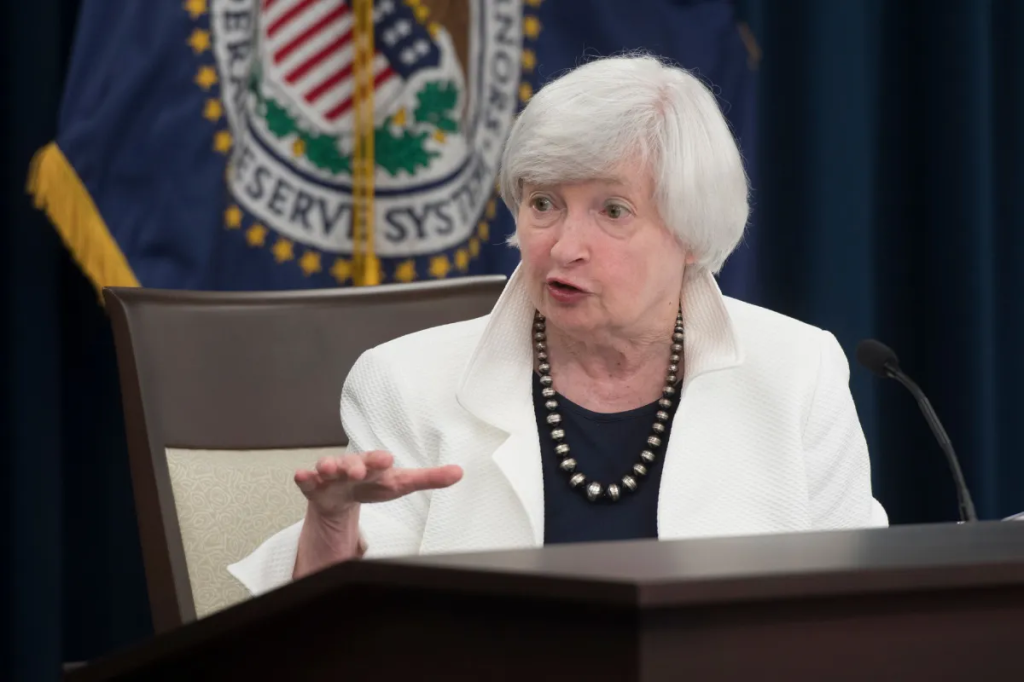A recap of insights, analysis and discussions we don’t want you to miss. Each month we compile key highlights from selected publications, events, and perspectives to provide you with a deeper look into the work we do at the New York Fed.
Did You #PopYourCollar?

To honor Chair Janet Yellen’s extraordinary tenure and legacy as the first woman Federal Reserve Chair, hundreds of employees from the New York Fed as well as from other Reserve Banks and central banks took to Twitter to “pop” their collars — a nod to Chair Yellen’s distinctive style. Before serving as Chair of the Federal Reserve from 2010 to 2014, Yellen served as Vice Chair of the Federal Reserve System and President of the Federal Reserve Bank of San Francisco.
#PopYourCollar for Chair Janet Yellen
Speech: What’s Next in Reference Rate Reform?

The topic was reference rate reform as Senior Vice President Lorie Logan spoke at this year’s Primary Dealer Meeting. Starting with a brief history of reference rates, the uncertain future of LIBOR (the London Interbank Offered Rate), and the financial industry’s work on reforms, Logan detailed the New York Fed’s role in reference rates.
“The New York Fed is committed to producing durable reference rates….that are robust and resilient, both now and in the future.”
— Lorie Logan, SVP, Markets Group
Logan, head of Market Operations Monitoring and Analysis, discussed how the New York Fed over the past two years has developed and maintained robust rates and best practices as reliable measures of market activity, including the enhancement of the Effective Federal Funds Rate (EFFR) and the launch of the entirely new Overnight Bank Funding Rate (OBFR). Next up is the launch of three new rates in Q2 2018 that will provide greater transparency into Treasury repo market activity:
- Tri-Party General Collateral Rate (TPGC)
- Broad General Collateral Rate (BGCR)
- Secured Overnight Financing Rate (SOFR)
Learn more about the expanded data collection, analysis, and enhanced technology that play a role in the rates.
Puerto Rico: Hurricane Resource Center and Small Business Owner Forum

The New York Fed has been monitoring developments in Puerto Rico and the U.S. Virgin Islands since Hurricanes Irma and Maria. In January, we partnered with PathStone Corporation to host “Apoyo Para Tu Negocio,” providing small business owners in Puerto Rico with recovery aid and assistance information from federal, local, nonprofit, and for-profit organizations. Attendance at the forum surpassed expectations, reflecting strong demand for services.
We also launched the Hurricane Resource Center for Puerto Rico and U.S. Virgin Islands, a central hub of curated resources, organized by topic, for business owners, homeowners, and renters impacted by the hurricanes.
In a recent blog post, our economists examine the hurricanes’ impact by looking at infrastructure, capital, and lost economic output, as measured by employment trends. We compare conditions to historical benchmarks from other hurricanes and assess nighttime light emissions to help assess economic activity and power outages.
Report: Survey of Consumer Expectations
What do consumers think about their prospects for earnings growth, job changes, and inflation? We share insights from our monthly Survey of Consumer Expectations, including:
- Expectations for earnings growth and unemployment improve to levels not seen since late 2014.
- After a sharp increase in November, median household spending growth expectations dropped 0.7 percentage points to 2.9%.
- Consumers expect inflation to rise over the short and medium terms.
About the Report: The Survey of Consumer Expectations is issued every month and focuses on consumers’ experiences and expectations regarding overall inflation and prices for food, gas, housing, education as well as job prospects and earnings growth.
Analysis: Balance Sheet Normalization

The Federal Open Market Committee’s decision to reduce the size of the Fed’s balance sheet — as outlined in the June 2017 Addendum — will gradually reduce the pace of reinvestments of Treasury securities and agency mortgage-backed securities (MBS).
In the first of two blog posts on the subject, we examine the fiscal implications of the Federal Reserve’s balance sheet normalization. We detail how various scenarios — with longer-run levels of reserve balances — affect interest rates, asset prices, economic activity, and inflation.
While Treasury securities will be reduced on a smooth predictable schedule, our second blog post explores the difficulty in assessing the size of agency MBS holdings. For example, borrowers have the option — at any time — to pay down any amount of the mortgage principal by making additional payments, refinancing the mortgage, or selling the home.
Stay Connected
Sign Up for In Review — our monthly email that highlights the latest work from the New York Fed.
Download our Economic Research Tracker to your iPhone® or iPad®
This article was originally published by the New York Fed on Medium.
The views expressed in this article are those of the contributing authors and do not necessarily reflect the position of the New York Fed or the Federal Reserve System.










